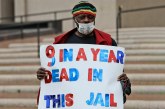 By Hannah Poploskie
By Hannah Poploskie
On the afternoon of November 8, the jury trial of Shelley Emerson began. Ms. Emerson is facing two misdemeanor counts, one of animal neglect and one of animal abuse.
The trial began with Judge David Rosenberg reading the pretrial jury instructions to the court. At their conclusion, he called for opening statements.
Attorney Frits van der Hoek, representing the People, began his statement with an explanation of the facts of the case. He told the court that on October 13, 2016, an officer was called to the residence of Ms. Emerson for a probation check.
Using photos of the residence as aids to his narrative, he showed that the house was in a state of squalor, with trash strewn about. With a photo of the backyard, Mr. van der Hoek informed the court that three dogs lived there with no food set out and just one source of water.
Another image showed a kennel that had a filthy blanket inside it. The backyard was described as smelling strongly of feces and urine. Photos were shown of feces throughout the backyard.
Regarding the animals, multiple photos were shown of the dog identified as “Haze.” He appeared to have missing fur and was favoring three of his four legs. A closer photo of the rear left leg displayed 
an injured leg that was partially hairless. The leg was thought to need amputation, but was later treated and saved.
The second dog was an older dog named “Macy.” The animal was severely underweight. The court was told that the cause of that condition was not able to be determined.
The first two dogs were actually owned by the daughter of the defendant; however, they were in the defendant’s care while the daughter resided elsewhere. The third dog at the residence had the defendant as the legal owner on the microchip.
The last dog was named “Hatchet” and was depicted in the image sitting awkwardly next to a fence. Mr. van der Hoek told the court that the dog was stationary due to having no movement of its hind legs. There were also allegedly calluses on the rear side of the front paws that indicted Hatchet would drag himself around as a way to be mobile.
Mr. van der Hoek concluded his opening remarks by telling the court that evidence will indicate neglect and suffering of these three animals while they were in Ms. Emerson’s care.
Deputy Public Defender Jose Gonzalez-Vasquez, representing Ms. Emerson, gave his opening remarks to the court. He said he understood that a visceral reaction would be had at the sight of unhealthy animals, but there were facts that when given to the jury would help them understand the entire situation was more than just the photos.
It was told to the court that Ms. Emerson loved all of the dogs, but there were multiple conditions that factored into her life. She was the breadwinner of the family, living with a partner suffering the effects of a head injury and a son who is disabled. Her other son had legal problems and was on probation. Ms. Emerson was doing the best she could in life despite these challenges, and she truly loved her animals. With this statement, Mr. Gonzalez-Vasquez concluded his opening remarks.
The first witness called by the People was an officer who went to the residence for a probation check. She confirmed that the photos provided to the court of the house’s condition reflected the scene at her arrival. She specified a seeing clutter inside of the home, as well as an odor of garbage.
When she arrived at the sliding glass door, it was dirty and hard to see through, but she saw what appeared to be a dog. When opening the door, she saw that the dog appeared to need medical attention so she called animal control and code enforcement. Mr. van der Hoek had no further questions.
In his cross-examination, Mr. Gonzalez-Vasquez asked if the defendant was at the residence, to which the witness confirmed she was not. Due to conditions of the home as well as the animal’s appearance, she had called code enforcement and animal control to the scene.
Continued questioning revealed that when the witness left the home with Ms. Emerson’s son in custody, no one else was home to care for the animals except animal control officers who were on the scene. The first witness was then dismissed from court.
The second witness was an animal control officer who was called to the scene. When shown pictures, the officer confirmed that she took the photos and they did reflect the cluttered nature of the home. Multiple pictures were handed to the jury of various areas of the backyard, and feces were confirmed in each photo – including on a blanket inside the igloo for the dogs.
The witness did not see any food in the various bowls present and, besides one bowl of discolored water, there was just a kiddie pool for a adequate water source.
The question then turned to the condition of the animals. The first animal, Haze, was reported as having a strong smell of decomposition and being partially hairless on her back. The skin on her leg looked irritated, bloody, had open wounds and appeared not to be able to bear weight, likely due to pain.
The dog identified as Macy was hiding behind a shed in the backyard and was reported as very thin with her ribs being able to be felt when she was patted. No other conditions were reported
The third dog Hatchet was identified through the photo previously shown of him by a fence. He did not move and could not stand without assistance. They removed Hatchet from the scene on a stretcher. When he was taken away, feces were found around where he was discovered by the officers.
Mr. Van Der Hoek questioned the witness further on the condition of Hatchet. It was testified, and shown in photographs, that his backbone, hips, and ribs were visible and his front toe nails were too long.
The witness was then asked about communication she had with the defendant. She reported that she called Ms. Emerson and informed the her that the dogs were in animal control’s custody.






